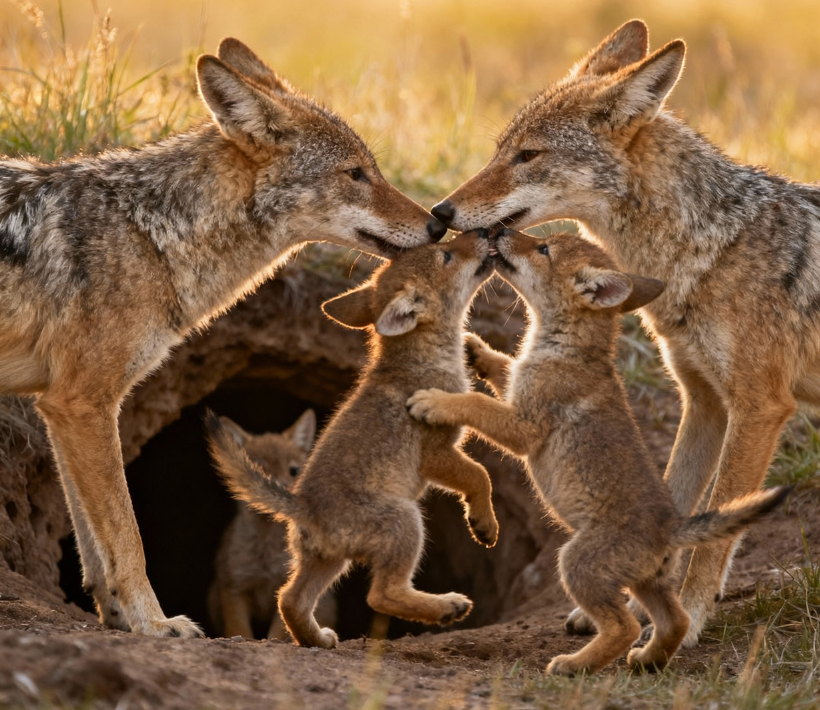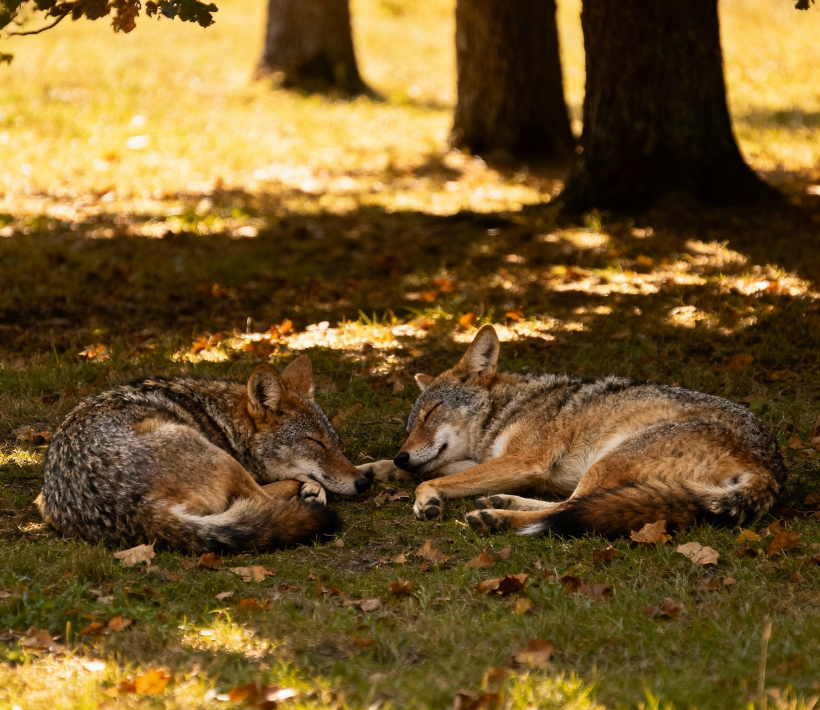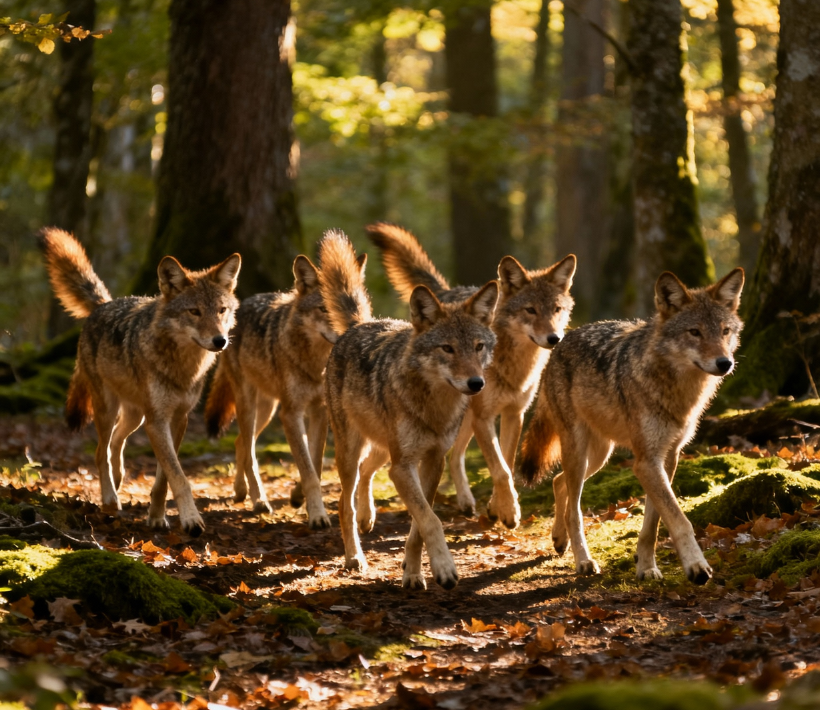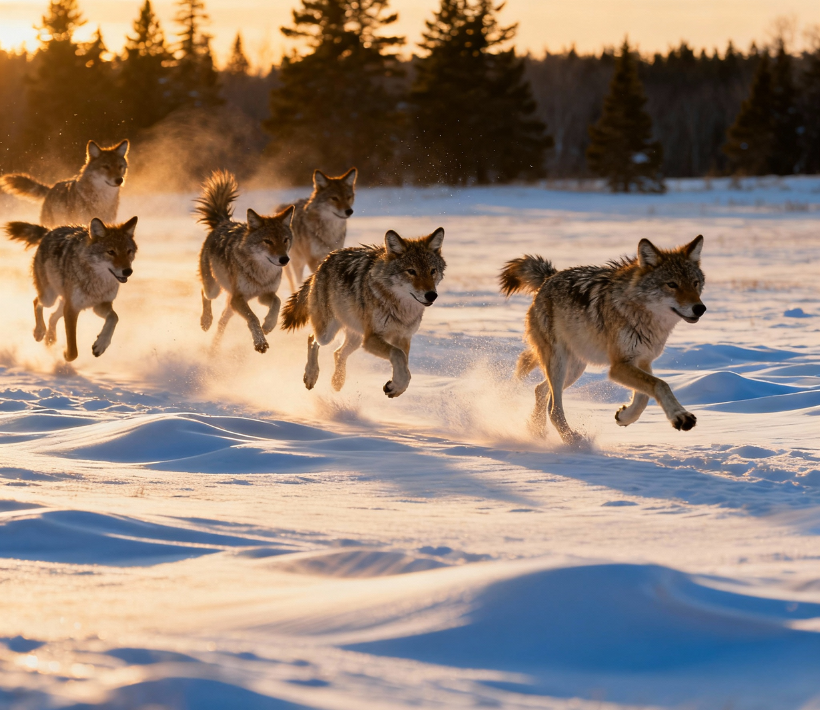Do Coyotes Travel in Packs? The Truth About Their Social Behavior
Introduction
Have you ever heard a chorus of howls echoing through the night and wondered if coyotes travel in packs? You’re not alone. This question puzzles many homeowners, hikers, and wildlife enthusiasts across the United States. The answer might surprise you because coyote social behavior is more complex than most people think.
Coyotes do form packs, but not in the way you might imagine. Unlike wolves that hunt large prey in coordinated groups, coyotes show flexible social patterns. They adapt their behavior based on food availability, habitat type, and population density. Understanding whether coyotes travel in packs helps you stay safe in coyote territory and appreciate these adaptable predators.
This article reveals the truth about coyote social structures. You’ll learn when coyotes group together, why they sometimes hunt alone, and what their pack dynamics actually look like in different environments.
Understanding Coyote Social Structure
What Defines a Coyote Pack?
A coyote pack differs significantly from what you see in wolf documentaries. Most coyote packs are actually family units, not large hunting groups. The typical pack consists of a breeding pair and their offspring from the current year.
These family groups stay together for specific purposes. The parents teach their young essential survival skills like hunting, territory defense, and communication. Pack membership remains fluid, with members coming and going based on age and circumstances.
Research shows that coyote packs rarely exceed six individuals. The breeding pair forms the core, while offspring usually disperse before reaching two years old. Some young adults stay longer to help raise the next generation of pups.
Pack Size and Composition
Coyote pack size varies by region and food availability. In areas with abundant prey, packs may include 5-6 animals. Food-scarce regions typically see smaller family units of 3-4 members.
Here’s the typical composition of a coyote family group:
- Alpha male and female (breeding pair)
- Current year’s pups (4-7 young)
- Yearlings (1-2 from previous year, occasionally)
- Transient helpers (rare, usually related individuals)
Western states often report larger pack sizes compared to eastern regions. This difference relates to prey availability and territory size. Larger territories with bigger prey animals support more pack members.
Do Coyotes Actually Travel in Packs?
The short answer is yes and no. Coyotes show remarkable flexibility in their social behavior. They adjust their grouping patterns based on immediate needs and environmental conditions.
Coyotes travel in packs primarily during specific seasons and situations. You’ll most likely see group travel during winter months and pup-rearing season. However, individual coyotes often hunt and travel alone, even when they belong to a family group.
Studies tracking coyote movements reveal that pack members spend significant time apart. They reunite at den sites, territorial boundaries, and occasionally for hunting. This flexible approach maximizes hunting efficiency while maintaining family bonds.

Seasonal Behavior Patterns
Winter months bring coyotes together more frequently. Cold weather and scarce prey encourage cooperative behavior. You might observe multiple coyotes traveling together during December through February.
Spring and summer mark pup-rearing season. The breeding pair stays near the den while teaching offspring hunting skills. Pack cohesion peaks during this period as parents coordinate to feed and protect their young.
Fall triggers dispersal behavior. Young coyotes leave their birth pack to establish territories. This season sees more solitary coyotes traveling across landscapes seeking unclaimed areas.
Urban vs. Rural Coyote Groups
Rural coyote packs maintain larger territories, sometimes exceeding 10 square miles. These groups hunt cooperatively for deer, rabbits, and other medium-sized prey. Pack structure remains more traditional with clear family units.
Urban coyotes show different patterns. City-dwelling coyotes often hunt alone due to abundant small prey like rats, cats, and garbage. Urban territories shrink to 2-3 square miles, reducing the need for large pack cooperation.
Suburban environments create a middle ground. You might see coyote packs in suburban areas that maintain family groups but hunt individually. These populations adapt quickly to human presence and food sources.
Why Coyotes Form Groups
Hunting Advantages
Cooperative hunting benefits coyotes when targeting larger prey. A single coyote struggles to take down an adult deer, but a small pack can succeed. Pack members employ relay tactics, with some animals resting while others maintain pursuit.
Rodent hunting, however, works better solo. Mice and voles provide single-serving meals that don’t require sharing. This explains why coyotes travel in packs less frequently in areas dominated by small prey.
Pack hunting proves most effective for medium-sized animals like:
- Young deer or fawn
- Adult rabbits and hares
- Groundhogs and marmots
- Injured or weak livestock
- Canada geese and other large birds
Territorial Defense
Territory defense ranks among the top reasons coyotes maintain pack structures. Family groups work together to patrol boundaries and chase away intruders. Solo coyotes face greater risks from neighboring packs.
Pack members leave scent marks throughout their territory. They coordinate howling sessions to announce their presence. These vocalizations warn neighboring groups and reinforce pack bonds.
Territorial disputes can turn violent. Coyote packs will attack and kill solitary intruders who refuse to leave. Pack membership provides crucial protection against these encounters.
Raising Pups Together
Pup survival depends heavily on family cooperation. Both parents hunt to feed the young, with the male bringing food while the female nurses. Older siblings sometimes delay dispersal to help care for new litters.
Den sites require constant protection. One parent typically guards the den while others hunt. This division of labor increases pup survival rates significantly compared to lone parents.
Young coyotes learn essential skills through pack interaction. They practice hunting techniques, social signals, and territorial behavior. This education period lasts 6-9 months before juveniles hunt independently.
Coyote Pack Hierarchy and Dynamics
The Alpha Pair System
Coyote packs operate on a breeding pair system, often called the alpha pair. These two dominant animals typically mate for life and lead all pack activities. The alpha male and female make decisions about territory, hunting, and den locations.
The alpha female controls reproduction within the group. She produces pheromones that suppress breeding in subordinate females. This ensures her pups receive maximum resources and attention from all pack members.
Alpha males defend territory boundaries aggressively. They lead territorial patrols and confront intruders. The alpha pair’s strong bond and cooperation determine pack stability and success.
Subordinate Members and Their Roles
Subordinate coyotes are typically offspring who haven’t dispersed yet. These younger animals help with hunting, territory defense, and pup care. They learn leadership skills while contributing to pack survival.
Non-breeding adults may remain with their birth pack for several reasons:
- Scarce territories in surrounding areas
- Strong family bonds with parents
- Abundant food supporting larger groups
- Protection from neighboring packs
Subordinates rarely challenge alpha authority directly. Instead, they wait for opportunities to disperse and establish their own territories. This system maintains pack stability and reduces internal conflict.
How Coyote Packs Differ from Wolf Packs
Wolf packs function as large, coordinated hunting machines. They pursue elk, moose, and bison requiring 6-10 pack members. Wolves maintain strict hierarchies and rarely hunt alone successfully.
Coyote packs are smaller, more flexible family units. They can hunt effectively alone or in groups depending on prey size. This adaptability has helped coyotes thrive while wolf populations declined.
| Characteristic | Coyote Packs | Wolf Packs |
|---|---|---|
| Average Pack Size | 3-6 members | 6-12 members |
| Territory Size | 2-15 square miles | 25-150 square miles |
| Primary Prey | Small to medium animals | Large ungulates |
| Solo Hunting | Common and effective | Rare and risky |
| Pack Stability | Fluid membership | Stable hierarchy |
| Human Tolerance | High adaptability | Low tolerance |
Wolves depend on pack cooperation for survival. A lone wolf faces starvation without group hunting. Conversely, solitary coyotes thrive in many environments. This independence explains why coyotes travel in packs less consistently than wolves.
Solo Coyotes: When and Why They Travel Alone
Solitary behavior is completely normal for coyotes. Many adults spend 50-80% of their time hunting and traveling alone, even when they belong to a pack. This behavior confuses people who expect constant group cohesion.
Dispersing juveniles represent the most common solo travelers. Young coyotes between 6-24 months old leave their birth territories seeking new areas. These transient animals may travel 100+ miles searching for unclaimed territories and mates.
Hunting efficiency often favors solo activity. Individual coyotes catch more mice, voles, and rabbits per hour than pack hunters. Small prey doesn’t require cooperation, making group hunting counterproductive for these meals.
Certain situations push coyotes toward solitary behavior:
- High population density forces individuals apart
- Abundant small prey eliminates cooperative hunting needs
- Death of a mate leaves breeding animals alone temporarily
- Territorial disputes drive subordinates away
- Human disturbance fragments pack cohesion
Lone coyotes successfully survive and breed in many environments. They establish smaller territories, hunt independently, and raise pups without pack support. This flexibility demonstrates why coyotes adapt to diverse habitats better than more social canids.

Coyote Communication Within Groups
Vocalizations and Howling
Coyote howls serve multiple purposes within pack dynamics. Group howling sessions strengthen bonds, coordinate activities, and warn neighboring packs. Each individual produces unique vocalizations that other pack members recognize.
The classic coyote chorus typically includes:
- Long howls – Location announcements and rallying calls
- Yips and barks – Alert signals and excitement
- Whines and whimpers – Submission and greeting sounds
- Growls and snarls – Aggressive warnings
Pack howling occurs most frequently at dawn and dusk. These sessions help separated members locate each other and reinforce territorial claims. A single pack’s howling can trigger responses from neighboring groups, creating extensive vocal exchanges.
Individual coyotes adjust their vocal patterns based on pack status. Alpha animals produce deeper, longer howls. Subordinates use higher-pitched sounds showing deference. Pups develop their voices through practice with older pack members.
Body Language Signals
Non-vocal communication plays a crucial role in pack interactions. Coyotes use tail position, ear orientation, and body posture to convey status and intentions. Understanding these signals helps you interpret coyote behavior during encounters.
Dominant displays include:
- Raised tail held high
- Erect ears pointed forward
- Direct eye contact
- Standing tall with stiff legs
Submissive behaviors show:
- Tail tucked between legs
- Ears flattened backward
- Avoiding eye contact
- Crouching or lying down
Play behavior strengthens pack bonds, especially among siblings. Young coyotes chase, wrestle, and practice hunting moves together. These activities teach cooperation skills needed for successful pack living.
Hunting Strategies: Pack vs. Solo
Solo hunting dominates coyote food acquisition. Individual coyotes use stealth, patience, and lightning-quick pounces to catch small prey. This method works best for mice, voles, ground squirrels, and insects.
The famous “mouse pounce” technique requires no assistance. A coyote listens for rodents under snow or grass, then leaps high and pounces with front paws. This behavior accounts for 50-70% of a coyote’s diet in many regions.
Pack hunting activates when larger prey appears. Cooperative strategies include:
- Relay pursuit – Pack members take turns chasing prey to exhaustion
- Ambush tactics – Some coyotes drive prey toward hidden pack members
- Distraction method – One coyote distracts while others attack from behind
- Cornering technique – Multiple coyotes surround and trap prey
Coyote packs show remarkable coordination when hunting deer. They target fawns, injured adults, or animals weakened by winter. Success rates increase dramatically with 3-4 hunters compared to solo attempts.
Scavenging represents another important food source. Coyote packs quickly gather at large carcasses like road-killed deer. The alpha pair eats first while subordinates wait their turn. This hierarchy prevents fighting over limited resources.
Geographic Variations in Pack Behavior
Western coyote packs in states like Montana, Wyoming, and Colorado tend toward larger groups. Open grasslands and mountainous terrain support populations of deer, elk, and pronghorn. These larger prey animals favor pack hunting strategies.
Eastern coyotes show interesting differences due to wolf hybridization. Northeastern populations contain wolf DNA, creating larger, more pack-oriented animals. These “coywolves” maintain bigger territories and hunt cooperatively more frequently than pure coyotes.
Southern coyotes in Texas, Arizona, and New Mexico adapt to arid conditions. Smaller prey dominance and water scarcity create more solitary behavior. You’ll find smaller family units with less pack cohesion in desert regions.
Urban and suburban coyotes across all regions show reduced pack behavior. Cities like Los Angeles, Chicago, and New York host thousands of mostly solitary coyotes. Human food sources, small territories, and persecution pressure favor independent living.
Regional prey availability dramatically affects whether coyotes travel in packs:
- Pacific Northwest: Moderate pack behavior, mixed prey
- Great Plains: Larger packs, abundant deer
- Northeastern forests: Strong pack structure, larger body size
- Southwestern deserts: Minimal packing, scarce resources
- Southeastern states: Small family units, diverse prey
What to Do If You Encounter Coyotes
Multiple coyotes together don’t automatically signal danger. Family groups traveling or hunting pose minimal threat to adult humans. However, you should take precautions and respond appropriately.
If you see a lone coyote or small group:
- Stop and stand tall – Never run, as this triggers chase instinct
- Make yourself large – Raise arms, open jacket, stand on rocks
- Make loud noise – Yell, clap, use whistles or air horns
- Throw objects – Rocks, sticks, or anything available (don’t need to hit them)
- Back away slowly – Maintain eye contact while creating distance
- Haze aggressively – Continue noisemaking until coyotes leave
Never approach coyote packs, especially during spring when protecting pups. Mother coyotes become defensive near den sites. The entire pack may respond to perceived threats against young.
Protect your pets by keeping dogs leashed and cats indoors. Small dogs resemble prey to coyotes, while larger dogs may trigger territorial responses. Walk pets during daylight hours and avoid known coyote areas during dawn and dusk.
Coyote attacks on humans remain extremely rare. Most incidents involve rabid animals or coyotes habituated to human feeding. Report aggressive or fearless coyotes to local wildlife authorities immediately.
Common Myths About Coyote Packs
Myth 1: Coyotes hunt humans in packs Truth: Coyotes avoid humans and attacks are extraordinarily rare. Documented fatal attacks number fewer than five in recorded history. Coyote packs focus on natural prey, not people.
Myth 2: Large packs of 20-30 coyotes roam together Truth: Coyote family groups rarely exceed 6-8 individuals. Reports of massive packs usually involve multiple families temporarily gathering at abundant food sources. These gatherings disperse quickly.
Myth 3: Coyotes will lure dogs away with pack tactics Truth: This behavior occasionally occurs, but not as a coordinated strategy. Individual coyotes may draw curious dogs away from owners, but this represents opportunistic behavior rather than sophisticated pack planning.
Myth 4: All coyote howling means a pack killed something Truth: Coyotes howl for many reasons including location communication, territorial announcements, and social bonding. Most howling sessions have nothing to do with kills.
Myth 5: Killing alpha coyotes destroys the pack Truth: Removing breeding pairs temporarily disrupts packs, but subordinates quickly fill leadership roles. New breeding pairs establish themselves within weeks. This resilience explains why lethal control programs rarely reduce coyote populations long-term.
Myth 6: Coyote packs attack livestock like wolf packs Truth: Most livestock predation involves solo coyotes or pairs, not packs. Opportunistic individuals cause more agricultural damage than family groups.
Key Takeaways
Here are the essential facts about coyote pack behavior:
- Coyotes do form packs, but these are small family units (3-6 members) rather than large hunting groups like wolf packs
- Pack structure is flexible – members spend considerable time apart, hunting and traveling alone
- Breeding pairs form the pack core, with offspring staying temporarily before dispersing to establish their own territories
- Cooperative hunting occurs selectively when targeting larger prey like deer, while solo hunting works better for small prey
- Geographic location and prey availability significantly influence whether coyotes maintain tight pack structures or operate independently
- Urban coyotes show reduced pack behavior compared to rural populations due to abundant small prey and smaller territories
- Seasonal changes affect pack cohesion – winter and pup-rearing periods bring families together more frequently
- Coyote packs pose minimal danger to humans – attacks remain extremely rare regardless of pack size

Conclusion
So, do coyotes travel in packs? The answer is more nuanced than a simple yes or no. Coyotes maintain flexible social structures that adapt to their environment, prey availability, and seasonal needs. These intelligent predators shift between solo behavior and family group coordination as circumstances require.
Unlike wolves that depend on large pack hunting, coyote packs function primarily as family teaching units. Parents raise offspring together, passing along crucial survival skills before young adults disperse to establish their own territories. This adaptability explains why coyotes thrive across North America while more rigid pack hunters struggle.
Understanding coyote social behavior helps you coexist safely with these wild neighbors. Whether you spot a lone coyote or a small family group, remember these animals avoid humans and play vital roles in controlling rodent populations. Their flexible pack structure represents evolutionary brilliance that deserves respect rather than fear.
Want to learn more about coyote behavior and wildlife coexistence? [Insert Internal Link to “Living with Wildlife” Guide] Share your coyote encounters in the comments below and help ot
FAQs About Coyote Pack Behavior
How many coyotes are typically in a pack? Most coyote packs contain 3-6 members consisting of a breeding pair and their current offspring. Occasionally, yearlings from previous litters stay with the family, bringing numbers to 7-8. Packs larger than this are extremely rare.
Do coyotes hunt in packs like wolves? Coyotes show flexible hunting strategies unlike wolves. They hunt alone for small prey like rodents but may coordinate as a pack when pursuing larger animals like deer. Their pack hunting is less organized and frequent than wolf hunting.
Why do I hear so many coyotes howling at night? Coyote vocalizations create an illusion of large numbers. A group of 3-4 coyotes produces overlapping howls, yips, and barks that sound like many more animals. This acoustic deception helps small coyote packs appear larger to competitors.
Will coyotes attack in a pack if I encounter them? Coyote attacks on humans are extremely rare regardless of pack size. Coyote packs typically flee from humans. Defensive behavior near dens represents the only significant risk, and aggressive hazing usually ends the encounter safely.
Do coyotes stay in packs year-round? No, coyote pack cohesion varies seasonally. Family groups stay closer during winter and pup-rearing season (spring/summer). Fall dispersal sends young coyotes away to find territories. Even pack members spend significant time hunting alone.
Can a lone coyote survive without a pack? Yes, solitary coyotes successfully survive and breed. Many adult coyotes live independently throughout their lives. Their adaptable diet and hunting skills allow solo survival in diverse habitats. Pack membership offers advantages but isn’t necessary.
How do you tell if coyotes are traveling together? Look for multiple sets of tracks following the same path, coordination in movements, or visual confirmation of animals staying near each other. Coyotes traveling in packs often move in loose formations rather than tight groups, making identification challenging.
What time of year do coyote packs form? Coyote packs are family units that persist year-round but show stronger cohesion during winter months and pup-rearing season (March-August). Late summer through fall sees reduced pack cohesion as young coyotes begin dispersing.

Hi, I am Raghav Ahuja a curious explorer, travel enthusiast, and the voice behind Travel The World Today. I believe in discovering the beauty of every destination without breaking the bank. Through my journeys, I share tips, stories, and travel guides to help you explore the world on a budget. Whether you’re a solo adventurer, a family traveler, or just planning your next escape, I’m here to inspire and guide you every step of the way.







Post Comment